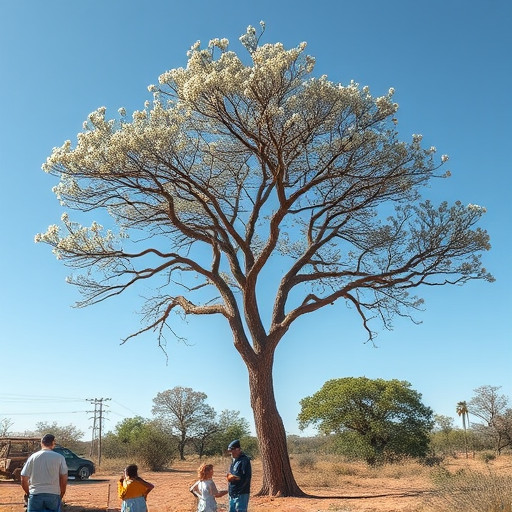The Acacia tree genus, with over 1000 species globally, is renowned for its adaptability across diverse climates and ecosystems. These trees play a crucial ecological role, providing food and habitat for wildlife, and have been an essential resource for humans for centuries due to their timber, medicinal properties, and edible pods. They are valuable in reforestation efforts, particularly in combating desertification. Facing critical risks from habitat loss, over-use, and climate change, conservation actions like reforestation, habitat protection, and sustainable harvesting are vital to safeguard these remarkable ecosystem contributors.
Acacia Tree: A Global Journey
The acacia tree, a versatile genus of woody plants, has captivated humans for centuries with its diverse species and far-reaching impact. This article takes you on a worldwide exploration of the acacia, examining its unique botanical traits and global diversity. From ecological roles to cultural significance, we delve into the habitats it inhabits and the traditional uses it holds. Additionally, we explore conservation efforts and prospects for the future, shedding light on the importance of preserving this remarkable tree species.
- Acacia Tree: A Global Overview
- Botanical Characteristics and Diversity
- Ecological Roles and Habitat Distribution
- Cultural Significance and Traditional Uses
- Conservation Status and Future Prospects
Acacia Tree: A Global Overview

The Acacia tree is a diverse genus of trees and shrubs, boasting over 1000 species worldwide. These plants are native to various regions, including Africa, Asia, Australia, and the Americas, showcasing their remarkable adaptability across different climates and ecosystems. Each species has unique characteristics, but many share common traits, such as their ability to thrive in arid and semi-arid environments, thanks to efficient water-use mechanisms.
Acacia trees are celebrated for their multifaceted roles in nature and human societies. They provide food and habitat for numerous wildlife species, with some acacia pods being a vital food source for herbivores. Humans have utilized acacias for centuries for their timber, medicinal properties, and as a source of food. The trees’ resilient nature has also made them valuable in reforestation efforts, particularly in regions facing desertification or land degradation.
Botanical Characteristics and Diversity

The Acacia tree belongs to the Fabaceae family, renowned for its remarkable adaptability and diverse range of species worldwide. These trees display a captivating blend of botanical characteristics, contributing to their widespread distribution and ecological significance. One distinctive feature is their ability to thrive in various environments, from arid deserts to humid tropical regions, thanks to their deep-reaching root systems and waxy, adaptive leaves that conserve water.
The genus Acacia encompasses hundreds of species, each with unique traits. They often exhibit thin, fissured bark, branching patterns that resemble a thorny shrub, and small, delicate flowers that range in color from white to yellow or even red. These floral variations not only add aesthetic allure but also attract diverse pollinators, underscoring the genus’ ecological versatility. The acacia’s multifaceted nature has made it a symbol of resilience and adaptability in many cultures, while also fostering numerous practical applications, from traditional medicinal uses to modern-day agricultural and environmental roles.
Ecological Roles and Habitat Distribution

The acacia tree plays diverse ecological roles worldwide, contributing significantly to their habitat’s biodiversity and functionality. These resilient trees are renowned for their ability to thrive in various climates, from arid deserts to subtropical regions, often dominating the vegetation in such environments. Their deep-reaching root systems not only stabilize soil but also facilitate water absorption, making them crucial in drought-prone areas where they help prevent desertification.
Acacias support a wide array of ecosystems by providing food and shelter for countless species. The trees’ nectar-rich flowers attract birds, butterflies, and bees, while their pods and leaves serve as sustenance for various animals. In many habitats, acacia trees are at the core of intricate food webs, making them indispensable for maintaining ecological balance and biodiversity. Their adaptability to different soil types and ability to grow in harsh conditions make them valuable tools in reforestation efforts and land conservation worldwide.
Cultural Significance and Traditional Uses

The Acacia tree holds significant cultural value across various parts of the world, often serving as a symbol of strength, resilience, and community in many indigenous societies. Its multifaceted uses have deeply rooted it in traditional practices. In some cultures, specific species are used for medicinal purposes, with their bark, leaves, or roots containing compounds that have been traditionally employed to treat ailments ranging from minor infections to more severe health conditions.
The wood of the Acacia tree is highly prized for its hardness and durability, making it ideal for crafting tools, utensils, and even construction materials. Its flowers are a source of nectar for bees and other pollinators, contributing to local ecosystems’ health. Moreover, the tree’s ability to thrive in arid and semi-arid climates has made it a valuable resource for stabilising soil, preventing desertification, and providing food and shelter for livestock in these regions.
Conservation Status and Future Prospects

The Acacia tree, known for its resilience and adaptability, has been a staple in various ecosystems worldwide. However, many species face significant threats due to habitat destruction, over-exploitation, and climate change. As a result, several acacia species are now classified as vulnerable or endangered on the IUCN Red List.
Conservation efforts are crucial to ensure their survival. Reforestation projects, protection of natural habitats, and sustainable harvesting practices can play a pivotal role in preserving these tree species. Additionally, research into their ecological importance and genetic diversity can help guide future conservation strategies, ensuring that these iconic trees continue to thrive for generations to come.
The acacia tree, with its diverse species and remarkable adaptability, plays a significant role in various ecosystems worldwide. Its unique botanical characteristics have led to diverse cultural uses and traditional practices. However, many acacia species face conservation challenges due to habitat loss and unsustainable practices. Protecting these trees is crucial for maintaining ecological balance and preserving their invaluable cultural heritage. Further research and global collaboration are essential to ensure the long-term survival of acacia trees in the ever-changing world.
